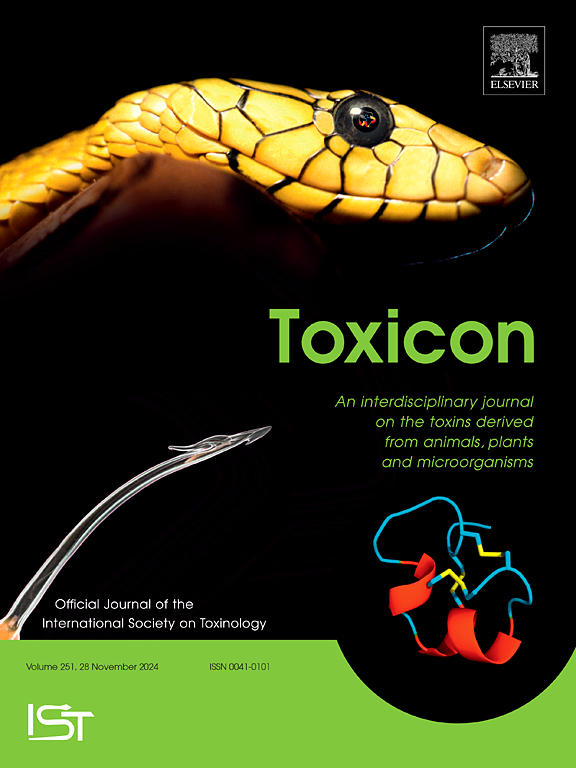A metabolomics and proteomics-based study on the metabolic effects of arecoline on the liver
IF 2.6
4区 医学
Q2 PHARMACOLOGY & PHARMACY
引用次数: 0
Abstract
Arecoline is one of the primary constituents of the areca nut. Its pharmacological effects include analgesia, anti-inflammation, and anti-allergy. Current researches on the toxicity of arecoline mainly focuse on oral carcinogenesis and immunotoxicity, so there are relatively little systematic study on its hepatotoxicity and underlying mechanisms. Therefore, this study aims to explore the mechanisms of hepatotoxicity induced by different doses of arecoline in mice by integrating metabolomics and proteomics. In our pathological results, we found that the medium and high dose groups of arecoline can cause fatty degeneration in the livers of mice. Additionally, the different doses of arecoline increased the levels of ALT and AST in the serum of mice. Proteomics research identified that exposure to different doses of arecoline primarily affected the PPARs signaling pathway, thereby influencing fatty acid metabolism, amino acid metabolism, and arachidonic acid metabolism pathways. Metabolomics research identified differential metabolites in each group after arecoline exposure. We observed that with increasing doses of arecoline, the metabolites of lipids and lipid-like molecules in mice gradually increased. The results suggested arecoline may induce fatty degeneration in the liver of mice through the PPARα/Acox-1 mediated pathways of oxidative stress, inflammatory response, energy, and lipid metabolism.

槟榔碱对肝脏代谢作用的代谢组学和蛋白质组学研究
槟榔碱是槟榔果的主要成分之一。其药理作用包括镇痛、抗炎、抗过敏。目前对槟榔碱毒性的研究主要集中在口腔致癌和免疫毒性方面,对其肝毒性及其机制的系统研究相对较少。因此,本研究旨在结合代谢组学和蛋白质组学,探讨不同剂量槟榔碱对小鼠肝毒性的作用机制。在我们的病理结果中,我们发现槟榔碱中、高剂量组可引起小鼠肝脏脂肪变性。此外,不同剂量槟榔碱使小鼠血清中谷丙转氨酶和谷丙转氨酶水平升高。蛋白质组学研究发现,暴露于不同剂量槟榔碱主要影响PPARs信号通路,从而影响脂肪酸代谢、氨基酸代谢和花生四烯酸代谢途径。代谢组学研究确定了槟榔碱暴露后各组代谢产物的差异。我们观察到,随着槟榔碱剂量的增加,小鼠体内脂类和类脂分子的代谢物逐渐增加。结果提示槟油碱可能通过PPARα/Acox-1介导的氧化应激、炎症反应、能量和脂质代谢途径诱导小鼠肝脏脂肪变性。
本文章由计算机程序翻译,如有差异,请以英文原文为准。
求助全文
约1分钟内获得全文
求助全文
来源期刊

Toxicon
医学-毒理学
CiteScore
4.80
自引率
10.70%
发文量
358
审稿时长
68 days
期刊介绍:
Toxicon has an open access mirror Toxicon: X, sharing the same aims and scope, editorial team, submission system and rigorous peer review. An introductory offer Toxicon: X - full waiver of the Open Access fee.
Toxicon''s "aims and scope" are to publish:
-articles containing the results of original research on problems related to toxins derived from animals, plants and microorganisms
-papers on novel findings related to the chemical, pharmacological, toxicological, and immunological properties of natural toxins
-molecular biological studies of toxins and other genes from poisonous and venomous organisms that advance understanding of the role or function of toxins
-clinical observations on poisoning and envenoming where a new therapeutic principle has been proposed or a decidedly superior clinical result has been obtained.
-material on the use of toxins as tools in studying biological processes and material on subjects related to venom and antivenom problems.
-articles on the translational application of toxins, for example as drugs and insecticides
-epidemiological studies on envenoming or poisoning, so long as they highlight a previously unrecognised medical problem or provide insight into the prevention or medical treatment of envenoming or poisoning. Retrospective surveys of hospital records, especially those lacking species identification, will not be considered for publication. Properly designed prospective community-based surveys are strongly encouraged.
-articles describing well-known activities of venoms, such as antibacterial, anticancer, and analgesic activities of arachnid venoms, without any attempt to define the mechanism of action or purify the active component, will not be considered for publication in Toxicon.
-review articles on problems related to toxinology.
To encourage the exchange of ideas, sections of the journal may be devoted to Short Communications, Letters to the Editor and activities of the affiliated societies.
 求助内容:
求助内容: 应助结果提醒方式:
应助结果提醒方式:


